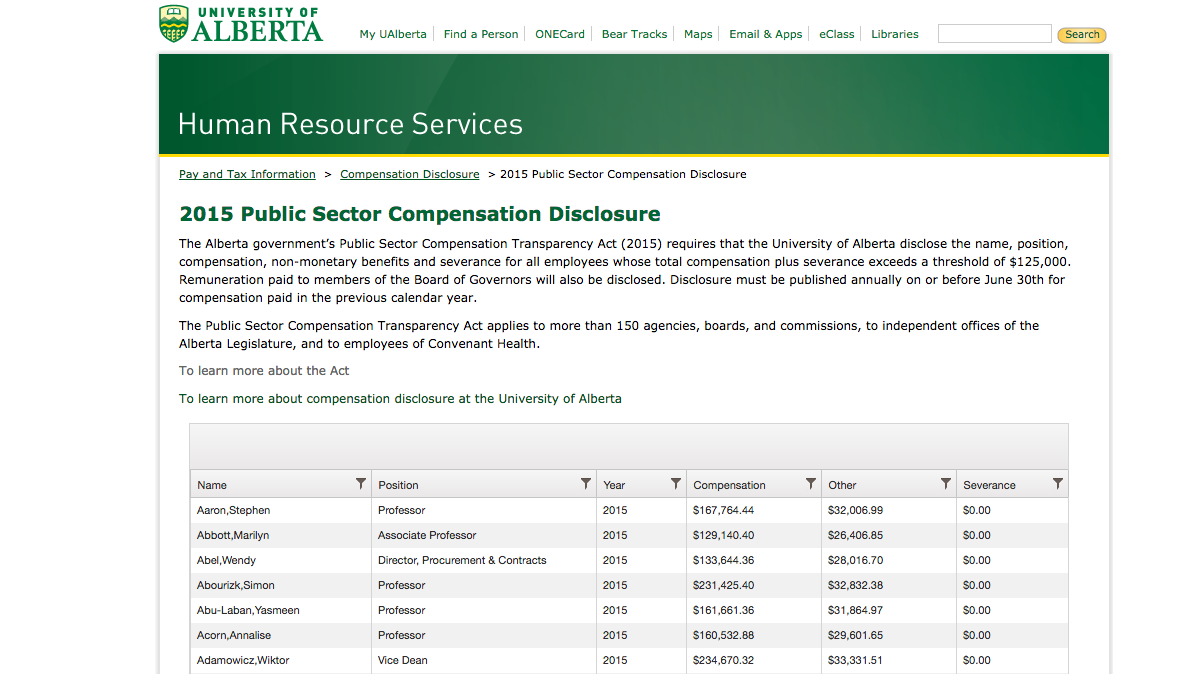Sunshine list reveals salaries of 1,507 university staff earning more than $125,000
 Supplied
SuppliedStudents now have easy access to data behind the high salaries of some professors — and the even higher salaries of university administrators.
The “sunshine list” reveals a smaller proportion of high-earning women at the university and a larger proportion of high-earning employees who do not teach. Among the top 15 highest earners of 2015: former U of A President Indira Samarasekera, professor and Alberta Health Services CEO Verna Yiu, two professors and three administrators of the Alberta School of Business, two professors of the Faculty of Engineering, and three university executives. Three of the highest 15 earners of 2015 are female.
Roughly a third of the university’s total salary budget went to the 1,507 individuals on the “sunshine list” — roughly 10.5 per cent of employees. These individuals included a quarter of the university’s non-faculty administrators and 58 per cent of faculty members, as well as 23 unpaid Board of Governors members.
Under the Public Sector Transparency Act passed in December 2015, post-secondary institutions are now required to annually release the salaries of all employees making more than $125,000 in the calendar year. Though the U of A waited until the province’s June 30 deadline to publish the salaries, University Provost and Vice-President (Academic) Steven Dew said the university is willing to increase transparency with the province’s new legislation. Publishing salaries does create “procedural challenges,” for the university, Dew said.
“Whenever there’s a compensation disclosure, it tends to put upward pressure on salaries,” Dew said. “We’re going to have to be able to respond to that … Once all of our employees know what colleagues are making, some will feel that they have to be paid more.”
With the price of oil being low, and university operating costs increasing every year, the university needs to be “fiscally responsible” with salaries going forward, Dew said.
Professor salaries at the U of A — including professors who are administrators — are the third-highest of Canada’s research universities. The university is paying professors at marketplace level, an average salary being $145,000, Dew said.
The U of A’s top 100 earners, whose salaries ranged from $568,321 to $266,053, earned a total of $33 million. Of these individuals, 44 did not teach. Provost Steven Dew said top earners are typically high-performance employees who have been at the institution for a long time and are likely involved in “extraordinary research activities,” which may involve holding a research chair position.
“(Institutions of this caliber) need to be prepared to pay a salary that will keep us at this level,” Dew said.
The university’s high compensation was justified by Dew as a requirement to keep good professors at the U of A, allowing it to compete in a global marketplace. In 2015, the U of A ranked 96th in the QS World University Rankings, scoring highest for its international faculty ratio and international student ratio while scoring lowest for its student-to-faculty ratio and research citations per faculty.
The salaries of the university’s top 200 earners totaled $58 million, with individuals making between $568,321 to $222,053. Less than a quarter of the top 200 were female, reflecting the “historical artifact of hiring 20 years ago” and market effects of certain faculties, Dew said.
“If you look at certain disciplines such as medicine, business, law, and engineering, they tend to be male-dominated,” Dew said. “They also are the (faculties) that, through market forces, tend to be the most highly-compensated.”
The U of A currently uses an employment equity policy called “Opening Doors,” approved in 1994. The policy set diversity targets, which included increasing the proportion of female university teaching staff to 28.4 per cent. In 2016, a study by the U of A’s Academic Women’s Association indicated the university’s professorate is 34 per cent female. Females currently make up a smaller proportion of all of the university’s top paid categories, including Board of Governors members (33 per cent), university leadership (37.5 per cent), deans (26 per cent), department chairs (31 per cent), distinguished professors (10 per cent), and full professors (26 per cent).
Dew said a working group will be assessing equity at the university in the upcoming year.
Correction: a previous version of this article reported erroneously that no staff member from the Faculty of Native Studies appeared on the sunshine list.




